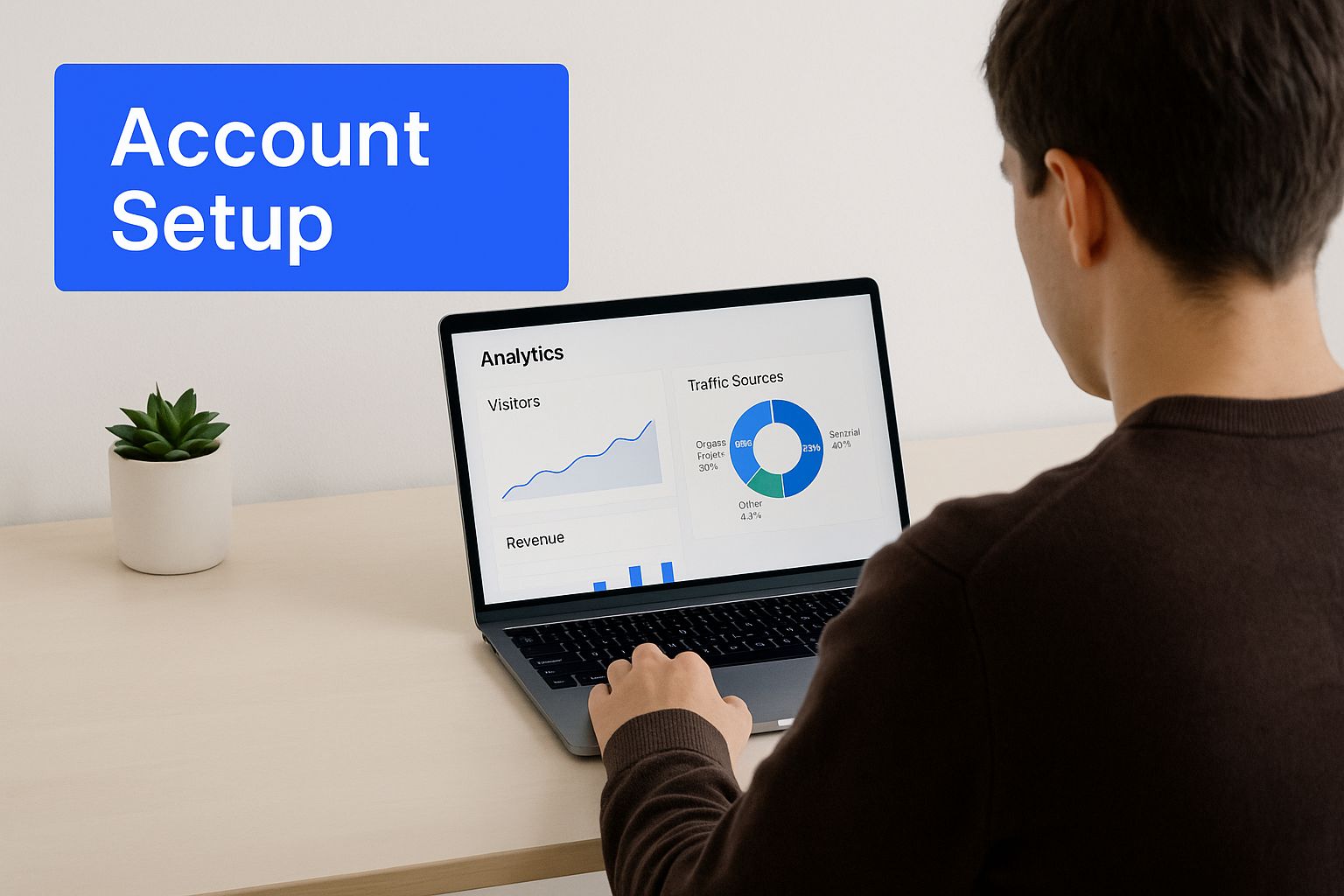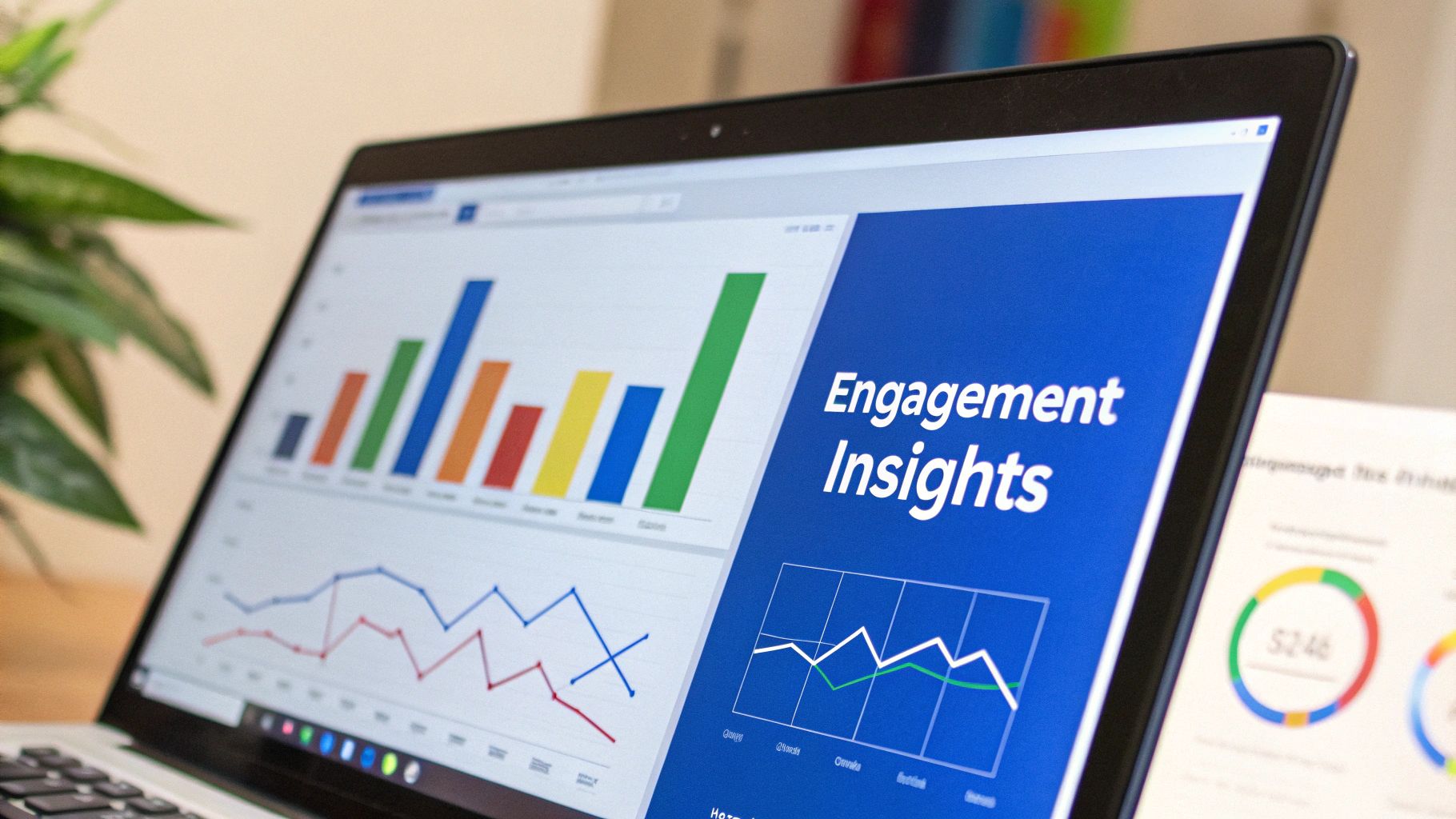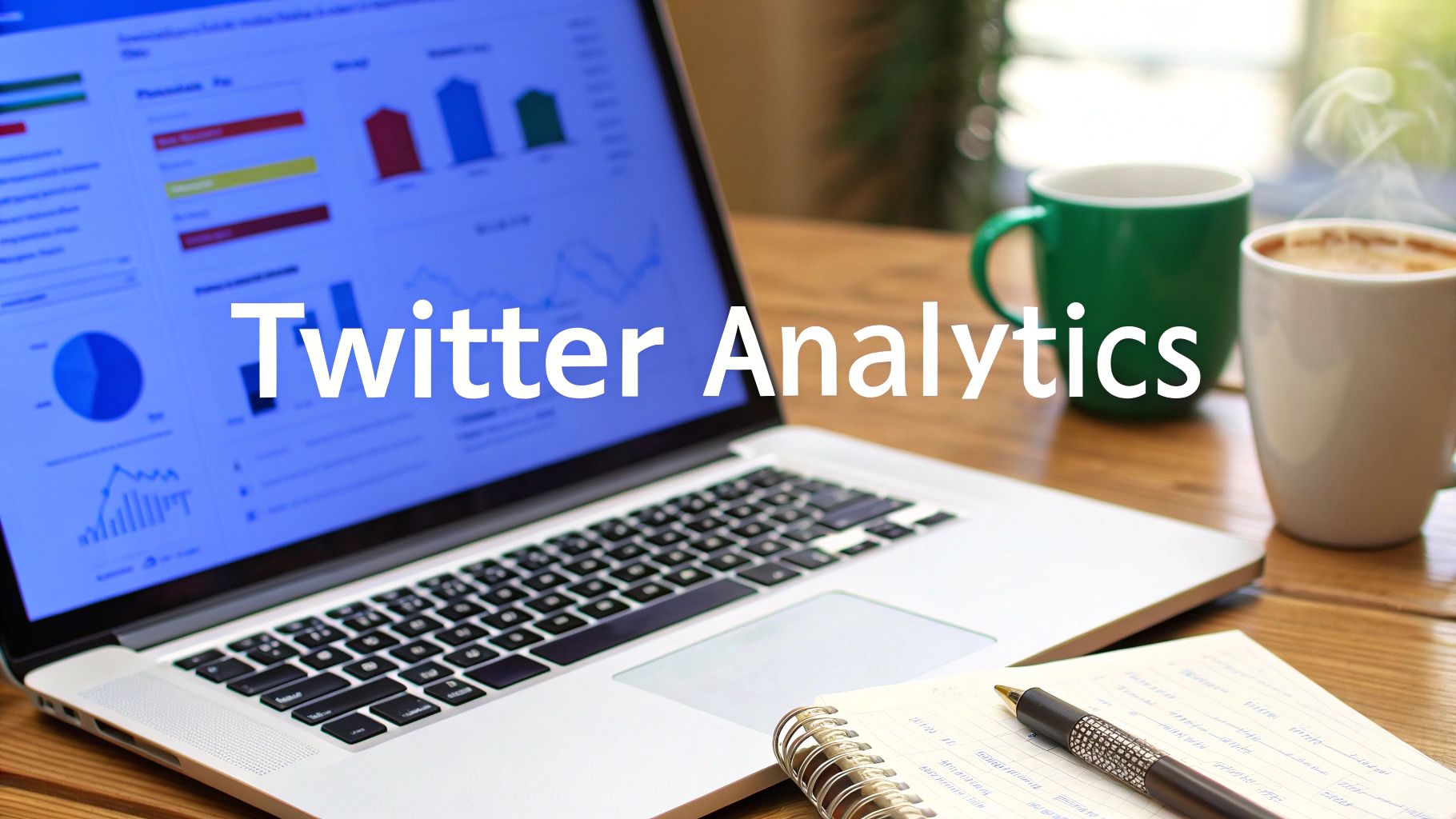Setting Up Your Twitter Analytics Account Like a Pro
Getting started with Twitter analytics (which, let's be honest, we all still think of as Twitter even though it's X now) can feel a little overwhelming. So much data! But trust me, focusing on a few key things upfront makes all the difference. If you want a broader view of how Twitter analytics fits into the whole digital marketing picture, this beginners guide to digital marketing is a great resource. It’ll help you see how X analytics plays a part in your overall online strategy.
First things first: accessing your Twitter analytics account is super easy. Just log in to X, go to the "More" tab, and click "Analytics." You'll see something like this:
This dashboard gives you a high-level overview of your account’s performance. Think key metrics like impressions, engagement, and follower growth – all laid out for you. From there, you can drill down into specific areas you want to explore. And pro tip: notice the timeline at the top. This lets you adjust the date range for your analysis, which is really handy.
Making the Most of Your X Analytics
Twitter (or X) analytics has come a long way, just like the platform itself. In 2025, X had over 611 million monthly active users globally. That's huge! It's a serious player in the social media world. And get this: that translates to about 7.8 billion minutes spent on the platform daily. That's a goldmine of data for your analytics account to work with. Here’s a deeper dive into some X stats.
One thing I learned the hard way: configure your account settings early. Make sure you’re tracking the data that actually matters to your goals. Are you trying to boost engagement? Increase brand awareness? Tailoring your settings from the get-go saves you a lot of hassle later on.
Decoding Your Twitter Dashboard: What Those Numbers Actually Mean
Let’s be honest, raw numbers without context are pretty useless. They're just noise. And that's where a lot of people get tripped up with their Twitter analytics. So, let's cut through the clutter and figure out what your dashboard really means.
This infographic shows a typical analytics dashboard during the account setup process:

Even from the very beginning, your Twitter analytics starts gathering intel. This early data is like your starting point – it helps you measure how much you've grown later on. For example, Impressions tell you how many times people have seen your tweets. Reach, on the other hand, tells you the number of individual people who saw them. See the difference? One person could see your tweet five times (5 impressions!), but reach would only count them once.
Diving Deeper Into Engagement
For more on engagement, this article is a great resource. Your engagement rate isn't just a vanity metric. It really tells you how much your content is resonating with your audience. I've seen accounts with tons of followers but practically zero engagement. And I've seen smaller accounts with super active, engaged communities. Which do you think is more valuable? It's all about quality over quantity. Think of your Twitter analytics account as a compass, guiding your content strategy in the right direction.
Identifying Key Metrics
So, which metrics should you really focus on? Here are the ones I find most useful:
- Link Clicks: How many people click on links in your tweets? This is huge if you're driving traffic to a website.
- Retweets: If people are retweeting your stuff, it's a good sign your content is shareable and resonates with them.
- Replies: Are people talking to you and about your tweets? Replies show how much conversation you're sparking.
- Profile Visits: Are people curious enough to check out your bio after seeing your tweets? This is a good indicator of growing interest.
To make things even clearer, I've put together a table summarizing the key metrics you should be tracking:
Essential Twitter Analytics Metrics Decoded: A comprehensive breakdown of key Twitter metrics, what they actually mean, and how to use them strategically.
| Metric | What It Really Means | Why It Matters | Healthy Benchmark |
|---|---|---|---|
| Impressions | Total number of times your tweets were seen. | Shows potential audience reach, even if they didn't engage. | Varies |
| Reach | Number of unique accounts that saw your tweets. | More accurate measure of how many people are actually seeing you. | Varies |
| Engagement Rate | How often people interact with your tweets (likes, replies, retweets). | Shows how well your content resonates with your audience. | 1-5% |
| Link Clicks | How many clicks your tweet links receive. | Measures effectiveness of driving traffic to external content. | Varies, but aim high! |
| Retweets | How many times your tweets are shared. | Indicates shareable, valuable content. | Varies |
| Replies | How many direct responses your tweets get. | Measures conversation and audience engagement. | Varies |
| Profile Visits | How often people visit your Twitter profile. | Shows growing interest in your brand/personality. | Varies |
This table shows you not just what the numbers mean, but why they’re important and what a good benchmark might look like. Remember, these benchmarks can vary depending on your industry and audience, but it gives you a starting point.
Use this data to figure out what's working and what's not. It's like having a backstage pass to your audience's thoughts! Use that information to tweak your strategy and double down on what's resonating.
Understanding Who's Really Engaging With Your Content
It’s easy to get caught up in follower counts, but your Twitter analytics account (now X) offers so much more than just vanity metrics. It's not about the quantity of followers, but the quality. Think of it like a party: a thousand people might show up, but if only ten are genuinely interested in chatting, those ten are your real crew. That's where the true value of analytics lies.
This deeper dive takes you beyond the surface. You can uncover valuable demographic data like location, language, and interests. Even better, you can see how people are engaging – are they retweeting your witty observations, replying with thoughtful comments, or just tapping the like button and moving on? This paints a much clearer picture of who's truly connecting with your content.
Analytics on X provide some serious granular detail. You can actually see the specific accounts that interact with you the most. This is gold! You can also track demographic info like region, language, and even estimated profession. Plus, you can filter engagement by topic to make sure your content is hitting the mark with the right audience. Check out resources like this one from Fedica to find where these analytics live: Find X Analytics in 2024 (Twitter). Want to get even more data-driven? Resources like this blog post from Project Aeon are super helpful: Data Analytics for Marketers.
Identifying Your Most Valuable Followers
Demographics are a good starting point, but identifying your power users is where things get interesting. Who’s consistently liking, retweeting, and sharing your content? These are the folks amplifying your message and extending your reach. Your analytics dashboard can help you find them.
Knowing who your most engaged followers are allows you to create even better content that resonates with their interests. It’s all about building a community of active, engaged users, not just accumulating a massive but passive following. A targeted approach is always more effective than shouting into the void. Combining this targeted approach with the rich data from your Twitter analytics will help you create authentic connections with the audience that matters most for your growth.
Timing Your Content for Maximum Impact

Ever put a ton of effort into a tweet, only to hear crickets? It's likely a timing issue. Your Twitter analytics account is like having a backstage pass to your audience's schedule. It shows you when they're online and ready to engage, so you don’t waste your brilliant content.
Forget those generic “best times to post” articles. Those are like trying to wear someone else's shoes – they rarely fit. Your Twitter analytics account gives you personalized insights. Dive into your historical data and see when your past tweets performed best. Those peak engagement times? That's your sweet spot. For more tips on nailing your tweet timing, check out this helpful guide: Learn more in our article about: the best times to tweet.
Time Zone Considerations
Think about your audience’s location. If you're tweeting about lunch while half your followers are asleep, you're missing out. Time zones are key, especially for a global audience. Scheduling tools with time zone features are lifesavers here.
Adapting Your Schedule
Timing isn’t one-size-fits-all, even for the same account. A quick, funny tweet might do well during the workday lull, while a longer, more in-depth thread might resonate better in the evening. Experiment! Try posting different content types at various times and see what works.
Don't be afraid to tweak your strategy. Your Twitter analytics account is a living document, not a static report. If engagement dips, adjust your schedule. This constant refinement is how you stay ahead of the curve and keep your content relevant. It’s all about hitting the right people at the right moment.
Let's talk about how the type of content you're sharing affects optimal posting times. I've found that my audience engages differently with different content.
To illustrate this, let’s look at some data-driven recommendations based on my own experience. This table outlines how I tailor my posting schedule for maximum impact:
Strategic Posting Times by Content Type
| Content Type | Optimal Time Window | Expected Engagement | Audience Behavior Notes |
|---|---|---|---|
| Quick Tips & News | 11 AM - 1 PM | High | People checking Twitter during lunch breaks |
| Thought-Provoking Questions | 5 PM - 7 PM | Moderate | More reflective engagement after work |
| Behind-the-Scenes Content | Weekends, 10 AM - 12 PM | Moderate | Relaxed weekend browsing |
| Blog Post Promotions | Tuesdays & Thursdays, 9 AM - 11 AM | High | Peak business hours, people looking for information |
As you can see, tailoring your posting schedule to the content and considering your audience's likely behavior can significantly impact engagement. By analyzing my own Twitter analytics account and experimenting with different posting times, I’ve been able to identify these key trends and optimize my strategy. Remember, this is just an example based on my own data. Your audience might behave differently! That's why using your analytics is essential.
Leveraging User Behavior Insights For Strategic Growth
The best X accounts don't just tweet randomly. They use their Twitter analytics account to see how people really use the platform. This isn't about gaming the system. It's about connecting with your audience authentically.
For me, analytics have been a game-changer in understanding who my most influential followers are. I've found that a small, engaged group often drives a big chunk of my reach. These aren’t always huge accounts, but they're active and interested in what I share. Building these relationships is gold for long-term growth. If that sounds helpful, you might find this Twitter growth guide focused on strategic replies useful for engaging your core audience.
Knowing how people consume your content is also critical. Analytics will show you what performs best and when. This lets you fine-tune your posting schedule and create content that resonates. It takes out the guesswork and lets you focus on what works.
Understanding Your Audience Through Data
Your Twitter analytics account is crucial for understanding user behavior, especially considering some interesting 2025 stats. In the US, just 10% of users create 92% of tweets. This highlights the importance of finding and nurturing your core audience, even if it's small. Check out more Twitter statistics here.
By using these insights, you can shift from posting randomly to a data-driven strategy. It’s about working smarter, not harder, and making your content truly effective. Turning your Twitter presence from a guessing game into a powerful growth engine is entirely possible with the right data.
Troubleshooting Common Analytics Challenges
Let's be honest, even when you think you've got a handle on your Twitter analytics account, things can still get messy. Sometimes the data just doesn't make sense. Maybe you're seeing weird discrepancies or a sudden drop in engagement that leaves you scratching your head. Trust me, I've been there. We all have.
One of the most common culprits is inaccurate tracking. Perhaps you recently switched up your Twitter handle or adjusted some settings in your Twitter analytics account. Double-checking that everything is configured correctly can save you a lot of headaches. Social media automation tools can be a lifesaver here, helping to keep everything streamlined. Another thing I’ve run into is that “gut feeling” mismatch – you know, when a Tweet feels like it’s performing well, but the data tells a different story. That's when you need to dig a little deeper and look beyond the basic metrics.
Diagnosing Data Discrepancies
If you're seeing crazy fluctuations or numbers that seem totally off, don't freak out. The first thing I always do is check the Twitter status page. Sometimes the platform itself is having issues, and that can definitely skew your data. I remember one time I saw a huge dip in engagement and nearly panicked, only to find out Twitter was experiencing a temporary outage. It happens!
Developing Backup Strategies
So, what do you do when your main analytics dashboard decides to take a vacation? Having a backup plan is essential. Something as simple as taking regular screenshots of your key metrics can be surprisingly effective. Personally, I also like to keep a spreadsheet to track my progress. That way, even if my Twitter analytics account is down, I still have access to my historical data. Calculating your own engagement rate can also be a good double-check. Here’s a helpful guide on calculating your Twitter engagement rate if you want to learn more.
Adapting to Twitter Updates
The thing about Twitter is, it's constantly changing. New features are always rolling out, and the interface can get a makeover without much warning. These updates can sometimes throw a wrench in your tracking efforts. The best advice I can give is to stay informed about Twitter updates and be prepared to adapt your analytics strategy as needed. Being flexible is key to staying on top of your Twitter game.
Turning Analytics Into Action: Your Strategic Roadmap
Data without action? It's just taking up space. Let's turn your Twitter analytics account insights into a real, working plan for growth. This section pulls everything you've learned about your analytics into a practical roadmap. We'll build frameworks for checking in regularly, define benchmarks you can actually hit, and figure out how to optimize your content based on what your specific data is telling you. Want even more ways to boost engagement? Check out this helpful guide on how to increase Twitter engagement.
Creating an Actionable Analytics Review Framework
Your Twitter analytics account isn’t a one-time grade, it's an ongoing chat with your audience. Regular check-ins are essential. I've found that setting a consistent schedule–weekly, bi-weekly, or monthly–helps me keep up with the data and catch trends as they pop up. Don’t get lost in the tiny details though. Focus on the metrics that actually matter for your goals.
Trying to get people to your website? Link clicks are king. Want to boost brand awareness? Impressions and reach are your focus.
Establishing Realistic Benchmarks for Measuring Progress
Benchmarking is key to measuring success. Don’t compare yourself to accounts with millions of followers; that’s not helpful. Look at similar accounts in your area and set realistic goals. Start small and build up. For example, if your current engagement rate is 1%, shoot for 1.5% next month. Celebrate the small wins! Trust me, it keeps you going.
Optimizing Your Content Strategy Based on Data
Your Twitter analytics account is a goldmine of information about what your audience likes. If your witty comments fall flat, but your insightful threads get people talking, guess what? More threads! Use your data to shape your content. Play around with different formats, posting times, and hashtags.
Your analytics will show you the sweet spot where your content really connects. It’s like having a cheat code for your audience.
As your account and goals change, so should your strategy. What worked at 1,000 followers might not work at 10,000. Be flexible and adjust your approach. Your Twitter analytics account is your compass, leading you toward real, lasting growth.
Ready to level up your Twitter game? Reply Guy helps you find trending conversations and engage with your audience at just the right time. Check it out and start growing your following today!
